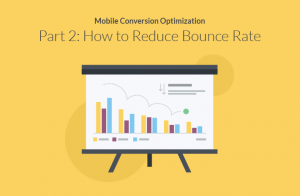Every year, major changes occur that seem to shake the SEO industry to its very foundations. 2016 was no different—all throughout the year we saw rising trends that went on to change the way we do SEO. Improving the user experience was a hot topic all year long, as was mobile-friendliness. And who can forget the ever-enduring regal status of content?
Now, with 2017 here at last, we find ourselves once again on the verge of redefining how SEO is done. Join us as we look to the very near future and see where SEO is headed with our Top 8 SEO Trends to Watch in 2017!

Content vs. Links
People say “Content is King,” but we all know links are still the biggest ranking factor. But if you look at what Google has been doing lately, it’s obvious they aren’t looking at links as the be-all and end-all anymore. Google has begun shifting their focus a bit, and plot twist—it isn’t user experience.
Rising SEO trends in technology like voice search (more on this later) are causing users to ask Google more complex, specific questions. And as a result, Google has tried providing users with more complex, specific results. The way they do this is by trying to better understand what users want.
Google has begun tuning its algorithms to focus more on the meaning behind each search query. The websites that best answer a query with quality, in-depth content will earn the higher spots on the SERPs.
So how can you turn this to your advantage in 2017?
Think “Intent over Keywords”
Because of the complexity and specificity of recent queries, keywords are becoming less important to an overall SEO strategy. And in 2017, we may even see a significant shift away from them. We’ve already begun using long-tail keywords to rank, which are more detailed by nature, so it shouldn’t be too hard to adjust your content to fit the new strategy.
Of course, you shouldn’t count out keywords completely. Keywords still add relevancy that can make a page a good match to a user’s search query. Whichever you decide, remember to build your content—and your links—around answering users’ questions. “Intent over keywords” is the name of the game for several of 2017’s top SEO trends. If you can successfully match up your on-page content to give users the information they’re looking for, your rankings will likely rise.

Security
Web security will always be a hot topic in our industry. 2015 was the year Google revived their #NoHacked campaign, which helped webmasters counter some of the web’s most common hacks. Although we saw our fair share of hacks in 2016, hacking seemed to be less of a trendy topic over the year, and as a result we saw less of an immediate effort to solve them. That’s about to change in 2017.

We’re slated to see a big change arrive in early 2017 that has to do with security and HTTP websites. Starting in January, Google Chrome will begin marking HTTP sites that use password and credit card fields as “insecure.” For now, the entire site won’t be marked insecure, only the offending pages. However, Google says this is “part of a long-term plan to mark all HTTP sites as non-secure.”
Condemning an entire site for being on HTTP may seem a bit harsh. However, consider how much more at-risk users are while visiting HTTP sites. The encryption of HTTP sites isn’t up to what other newer protocols can handle. That threat of risk could cost you a customer, so why stick to HTTP?
All last year, Google encouraged webmasters to switch to HTTPS. They even began indexing HTTPS pages by default. Will 2017 be the year we see the next step in their anti-HTTP campaign? We don’t think we’ll have to wait long to find out.

Digital Assistants and Local Search
Digital assistants like Google Home, Alexa, Siri, and Cortana are on the rise. The act of simply asking a question and hearing (re: not having to read) an answer is adding a new level of convenience to users, especially on the local search level. Local queries are often asked in the moment (“Where is a pizza place near me?”), and the digital assistants housed inside mobile devices are able to serve up instant answers.
We expect several local SEO strategies centered around taking advantage of digital assistants will establish themselves in the new year. The simple task of completely filling out your Google My Business page is a good start. Other more complex strategies will be using structured data to improve the relevancy of key landing pages to bring nearby users to a business’s physical location. Which brings us to…
More SERPs Experiments
We all know Google loves to experiment. And the place Google enjoys running experiments most is in the SERPs. Increasing the length of meta descriptions and titles was just one of the many surprises Google threw at us over the course of the year. What kinds of experiments will we see from Google in 2017?
Rich Snippets
Rich snippets are Google’s way of spicing up the search results. Rich snippets help users find answers before they even make their first click. Since the debut of rich snippets in 2009, we’ve seen them introduce breadcrumbs, recipes, review ratings, videos, and many more different types of snippets. As Google invents new snippets, webmasters will have to double their efforts to ensure they’re putting structured data on the right pages to get them featured as rich snippets.
We expect to see snippets more tuned to mobile users and the immediacy they crave. Maybe they’ll have an eye-catching design, or will be placed just right for maximum clickability. No matter what form they end up taking, be sure to stay on top of your structured data to take advantage of them when they come up.

Go Mobile or… You Get the Idea
2016 was a tremendous year for mobile. Google released AMP pages, a mobile-friendly algorithm update, and is working on making mobile its primary index.
Will we see as big a push for mobile in 2017? Perhaps, but we think it’s unlikely. Oh, we have no doubt we’ll still see plenty of news about Google’s upcoming mobile features. But look at it this way—Google has laid the groundwork for its mobile-first world, and now that it’s here you’re either mobile-friendly or you’re in BIG trouble. It’s up to you to take the necessary steps to stay relevant, and that means mobile.
We expect we’ll learn more about Google’s mobile-first index in 2017. If we do get an official announcement, webmasters who haven’t gone mobile-friendly will no doubt feel the fire being set under their them. Google committing to the mobile-first index would be a serious step toward cementing mobile as the undisputed future of SEO.
Machine Learning
It’s been over a year since the announcement of RankBrain, Google’s new machine-learning AI. At the time, it was already the third-most important ranking signal, right under content and links. As it refines its algorithms, we may see RankBrain emerge as the industry-defining change of the year.
Google’s AI is already able to process a ton of data. It looks at all the clicks and impressions it gets (and more importantly, even the clicks it doesn’t get) to learn and adapt its algorithms more quickly and efficiently than Google’s programmers have been able to. You might find it impossible to keep up following the traditional SEO methods.
So what can you do in light of all this machine-learning business? The answer—maybe nothing. At least, nothing like what we’re used to doing. We talked before about how keywords, the way we’ve been using them, may go the way of the dinosaurs. And as before, the solution is the same—focus on the intent of the user.
Remember—the intent of queries is becoming more important than the words themselves. Google’s AI-designed algorithms can better learn and adapt to how users are searching, which makes Google effective at serving their user base. RankBrain will be changing all the time, but as long as your site is serving the user’s purpose, you should have what it takes to survive.

Voice Search
What’s easier than typing a question to Google? That’s easy—asking your question out loud and having the answer read back to you. 50% of teens and 21% of adults use voice search every day, proving it a good fit for today’s on-the-go lifestyle. Mobile devices facilitate this ease, as smartphones currently inhabit a positively huge number of pockets and purses and are available at a moment’s notice.
Research shows 43% of voice searches occur at home, while 36% occur in the car and 19% happen while on the go. People don’t just use voice search while they’re out and about, but whenever their hands are busy. That can happen anywhere and at any time! With voice search getting better all the time at word recognition, search engines need to work double time to get to the heart of each query.
What does voice search mean for SEO?
Voice search queries have some distinct characteristics:
- They don’t look like the traditional phrases typed into Google’s search bar.
- They’re much more conversational in nature.
- They’re usually composed of whole sentences that ask exactly what the user wants to know.
As part of an SEO strategy, you don’t have to account for each and every permutation of a phrase someone will use to find your site. Instead, you can capture the intent of their query. (Are you seeing a pattern here?)
As we’ve stated several times already, you should still use keywords for your site. Keywords can show the search engines how your site relates to a user’s query. For example, a user asking “Where’s the closest place to buy a tennis racquet?” could find your place of business if you’re ranking for “tennis racquet” in the user’s location. If anything, voice search makes it easier for you to focus on answering users’ questions with quality content—yet another alternative to the keyword stuffing you should already be avoiding! As long as your site content answers the user’s query, you can take advantage of voice search.
If you’ve been working on other things lately, this is the year to make a serious effort to fill out your pages with relevant, helpful content. So you’d better make sure your content is the best it can be. That way, when the dulcet tones of Siri, Cortana, or Google Assistant read your page, users will be dying to know more.

Site Speed
We’ve seen voice search and machine learning on just about every “SEO trends for 2017” blog out there. These topics are as trendy as they come, as they’ve only come about in the past couple years or so. Still, we’re surprised we don’t see more mention of site speed as a major trend for the new year.
Many webmasters overlook site speed in favor of appearance or user experience. Google has constantly been telling us how important those are, but the difference between a user staying on your page could have less to do with how pretty it looks and more to do with how fast the page loads. Considering that amount could be only a couple seconds, we’re surprised site speed isn’t more of a priority.
As we said, UX is still important. But the ease-of-use of your menus will only do so much to retain a customer—especially when weighed against how long your pages take to load. If you prioritize site speed, you’re much more likely to keep those users on the page.
Don’t make the mistake of thinking a pretty WordPress theme will make up for slow load times. Most users won’t wait longer than 3 seconds for a page to load. Fix your site speed, and reap the benefits in 2017.
Follow These SEO Trends Closely
Here’s a recap of the top 8 trends to watch this year:
- Content vs. Links
- Security
- Digital Assistants and Local Search
- Rich Snippets
- Mobile-Friendliness
- Machine Learning
- Voice Search
- Site Speed
If you want to come out on top in 2017, these are the SEO trends to follow. Paying attention to even just a few of them (we expect big things from Content, Rich Snippets, and Site Speed) could have huge benefits for your SEO campaigns next year.
Digital & Social Articles on Business 2 Community(50)





